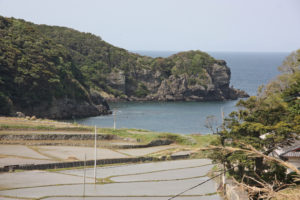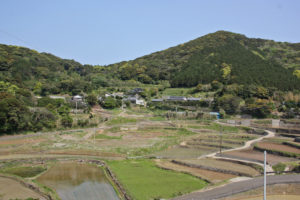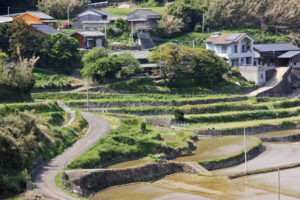26 Saints Pilgrimage route on January 29 in 1597
The route of this day was from Akama in Munakata to Wajiro, the distance
was 21 km.
 |
 |
 |
Started at Akama accommodation and using Karatsu walking road, they went to
Wajiro passing through Koga and Shingu.
 |
 |
 |
Accommodation was Wajiro where faced Hakata bay, in order to cross from
Saitozaki to Shikanoshima the next day.
Shimabara Peninsula Martyrs Memorial Cathedral
This Cathedral is house of prayer for tens of thousands Christians who were martyred
between 1612 and 1658 throughout the Shimabara Peninsula.
 |
 |
 |
It was built in 1997 to commemorate the 400th anniversary of the martyrdom of 26
Japanese Saints and the 360th anniversary of the Shimabara Rebellion.
The Cathedral is a beautiful octagonal building with a large octagonal dome.
26 Saints Pilgrimage route on January 28 in 1597
The route of this day was from Kokura in Kitakyushu to Akama in Munakata via Koyanose ,
the distance was 34.5 km.
Started at Kokura accommodation around Kokura Castle, and walked to Tobata port
along the Kanmon Strait.
 |
 |
 |
Transfered to Wakamatsu from Tobata by a boat.
 |
 |
 |
Walked to Akama through Ashiya and Koyanose, and then stayed at Akama.
 |
 |
 |
26 Saints Pilgrimage route on January 27 in 1597
There were 24 martyrs when they started Kyoto, but two more martyrs were added in
Shimonoseki, then became 26 martyrs in total.
The route of this day was from Karato in Shimonoseki to Kokura in Kitakyushu.
Rode on the boat at Karato, and transfer to Dairi in Kitakyushu
|
Karato |
Kanmon Strait |
Dairi |
They landed at Dairi and walked 6 km along the coastline of Kanmon Strait to Kokura,
where was the place to stay.
 |
 |
 |
It is said that they stayed around Kokura Castle.
 |
 |
 |
Japan’s first Seminary
In 1579, Priest Alessandro Valignano of Jesus from Portugal came to Japan to inspect
the situatin of missionary work in Japan.
Valignano believed that training Japanese priests and monks was the key to the success
of missionary work in Japan.
And then, he made the Japan’s first Seminary in Shimabara peninsula in 1580, where was
the Hinoe Castle town of Arima Harunobu.
 |
 |
 |
Among the first students, included member of Tensho youth mission to Europe who were
Ito Mansho Ito, Chijiwa Miguel, Hara Martino and Nakaura Julian.
Note : Seminary is an educational institution established in Japan by the Society of Jesus
between 1580 and 1614 to train Jesuit priests and monks.
Hidden Christian site, Kasuga Village
Kasuga Village and Mount Yasugatake is a Christian Pilgrimage site and is registered on
the World Heritage as Hidden Christian Sites in the Nagasaki Region.
 |
 |
 |
This idyllic, remote village was refuge to a small community of Hidden Christians who
practiced here for centuries, far from the prying eyes of the government. After the ban on
Christianity was lifted, the local villagers decided to continue practicing their own unique
brand of the religion rather than rejoin the Catholic Church. As a result, churches were not
erected in the village, and the religion remains outwardly invisible.
Hidden Christians
Oppression against Christians began with the Tokugawa shogunate’s ban
on Christianity. The missionaries were expelled to oversea countries, and
those who remained secretly in Japan were also captured and martyred.
Konishi Mansho who was the last Priest during the ban on Christianity,
was also martyred in 1644.
In the absence of priests, believers pretended to be Shinto or Buddhist
ostensibly in order to protect their faith.
The Christian organizations were created in each village to continue the
Christian faith and the faith was passed down from parents to children and
from children to grandchildren.
 |
 |
 |
Hidden Christian
Even after lifted ban on Christianity, people who continue to practice their
faith in the same way as before are called “Hidden Christians”.
Hidden Christians in Nagasaki have been passed down since the ban on
Christianity in Hirado, Ikitsuki, the Goto Islands, Sotome, and around Nagasaki.
Kurose no Tsuji, martyrdom site of Gaspar Nishi Genka
The site where Christian Gaspar Nishi Genka was martyred in 1609, located on
Kurose Hill overlooking Nakae no shima between Hirado and Ikitsuki.
The tomb facing the sea is called Gaspar-sama and is a revered place for Ikitsuki’s
Hidden Christians.
The cross-shaped “Kurose no Tsuji Martyrdom Monument” was erected by Catholics
in 1991, and Mass is held every year around November 14th.
 |
 |
 |
Gaspar Nishi Genka was the first martyr of Ikitsuki and the father of Thomas Rokuzaemon
Nishi who was one of the 16 Saint of Nagasaki, dedicated in Nakamachi Church in Nagasaki.
Saint Filippo de Jesus Church ( Japan 26 Saints Memorial Church )
This is a church with Gaudi-style twin tower designed by Kenjiro Imai,
built next to the Nishizaka Martyrdom site
 |
 |
 |
When there was a plan to build a memorial hall for the 26 Japanese Saints
next to Nishizaka Martyrdon site, a large donation was made from Mexico,
and the Church was built in 1962.
This church is dedicated to Mexican Filippo de Jesus, who is one of the 26 Saints.
Filippo de Jesus was a Franciscan Catholic missionary who became one of the
26 Martyrs of Japan, the first Mexican Saint.
History of Japanese Christianity
Christian history in Japan was started when St. Francis Xavier came to Japan as a first Christian
missionary in 1549. Then Christianity was spread in Nagasaki region. However, unparalleled
hidden Cristian history was started from when Toyotomi Hideyoshi Shogunate proclaimed Christian
ban in 1587. During ban on Christianity, people secretly continued to faith while surviving in the
midst of the conventional society and Japanese religions.
Since ban on the Christianity was lifted in 1873, new Christian history in Japan has begun.
1549 St. Francis Xavier came Kagoshima Japan as a first Christian missionary and
commenced the Christian history in Japan
1550 St. Francis Xavier came Hirado as a Christian missionary
1551 Catholic Hirado Church was constructed as first church in Japan
1557 Introduction of Catholicism to Ikitsuki, Kasuga in Hirado
1563 Omura Sumitada, feudral lord of Nagasaki who was first lord convert to Christianity
1569 Todos os Santos Church was constructed as first in Nagasaki by Gaspal Villera
1571 Nagasaki Port was opend to Portugal by feudral lord Omura Sumitada
1580 Arima Harunobu, lord of Arima convert to Christianity and the Seminario was
established in Kuchinotsu as first in Japan
1582 Arima Harunobu teamed up with Kyushu Christian lords Otomo Sorin and ura Sumitada
to dispatch the Tensho Mission to the Pope in Rome
1587 Shogunate, Toyotomi Hideyoshi proclaimed Christian ban
1590 The Tensho Mission retured to Nagasaki
1597 The Twenty-Six Martyrs of Japan, were a group of Catholics who were
executed by crucifixion on February 5 at Nagasaki. Their martyrdom is especially
significant in the history of the Catholic Church in Japan.
 |
 |
 |
1603 Tokugawa Shogunate was established and the natioal isolation policy was applied
1614 The Tokugawa Shogunate prohibited Christianity throughout Japan
1622 five Christians were martyred at Nakae no Shima in Hirado
1624 three Christians were martyred at Nakae no Shima in Hirado
1627 twenty seven Christians were martyred at Unzen Jigoku
1637 Shimabara Rebellion : a peasant uprising against bakufu’s persecution of Christians
under the leadership of Amakusa Shiro
1637 Lorenzo Luiz from Philippines martyred at Nashizaka hill in Nagasaki
1641 Dejima, the small artificial island was opened as Dutch trading port in Nagasaki
1644 Last Christian missionary in Japan is martyred
 |
 |
 |
1853 Mathew C Perry came to Uraga; the Commodore of the US navy, who played a
significant role in Japanese history, succeeded in opening Japan to foreign countries
1854 Treaty between the USA and Japan : ending the isolation policy and opening the country
1858 Treaty of Amity and Commerce between USA, Netherlands, Russia, England, France and
Japan ; allow religious freedom in foreign residential areas
1862 The 26 Japanese Martyrs at Nishizaka Hill in Nagasaki were canonized by Pope Pius IX.
1865 Oura Cathedral was built as the basilica of Martyrdom of the 26 Saints of Japan
1868 Meiji Restoration, the most important event in Japanese history, which heralded a new era
of modernization in Japan. This revolution restored the imperial rule to Japan after more
than 250years of Tokugawa Shogunate
1873 Ban on the Christianity was lifted
1882 Shitsu Church in Sotome construction started by Father de Rotz’s design
1909 Shitsu Church was completed
1914 Urakami Cathedral construction was completed, it was the largest Catholic church in East Asia
at that time
1912 Yamada Church in Hirado was constructed
1917 Tabira Church in Hirado was constructed
1920 Kurosaki Church was completed by Father de Rotz’s design
1931 St. Francis Xavier Memorial Church in Hirado was constructed at the present location
1945 Atomic bomb dropped in Nagasaki on Aug. 9
The most part of Nagasaki was destroyed, and a tremendous number of lives were lost.
and Urakami Cathedral was completely destroyed.
About 73,000 died instantly, and up to 60,000 were injured.
 |
 |
 |
1950 Pope Pius XII designated the Nishizaka Hill in Nagasaaki of Martyrdom of 26 Japanese
Saints as an official Pilgrimage site for Catholics
1959 Urakami Cathedral replacement was built
1981 Pope John Paul II visited in Nagasaki
1982 Saint Teresa of Calcutta commonly known as Mother Teresa visited in Nagasaki
1987 Saint Lorenzo Ruiz was canonized by the same pope in the Vatican city on 18 October,
making him the first Filipino Saint
2000 Ebdo Shusaku ( novelist of Silence ) Literary Museum is opened in Sotome
2018 Hidden Christian site is registered on UNESCO’s World Heritage
 |
 |
 |
2019 Pope Francis visited Nagasaki on Nov.24 and and calls for a ‘world without Nuclear
Weapons’ at the Ground Zero.
Home Our Services About us Contact us Kyushu Travel Guide



